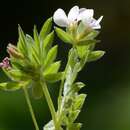en
names in breadcrumbs


Ornithopus sativus, the serradella or common birdsfoot, is a species of flowering plant in the family Fabaceae.[2] It is native to Southwestern Europe and Northwest Africa in Portugal, western Spain, northern Morocco and Algeria, and southwestern France and has been introduced as a legume forage to many locations around the world, including most of central and eastern Europe, Turkey, the Caucasus, the Azores, South Africa, Kenya, Java, most of Australia, the North Island of New Zealand, southern Chile, and California.[1][3] It is known for producing a high‑quality forage in highly acidic, nutrient‑poor soils.[4]
The following subtaxa are accepted:[1]
Ornithopus sativus, the serradella or common birdsfoot, is a species of flowering plant in the family Fabaceae. It is native to Southwestern Europe and Northwest Africa in Portugal, western Spain, northern Morocco and Algeria, and southwestern France and has been introduced as a legume forage to many locations around the world, including most of central and eastern Europe, Turkey, the Caucasus, the Azores, South Africa, Kenya, Java, most of Australia, the North Island of New Zealand, southern Chile, and California. It is known for producing a high‑quality forage in highly acidic, nutrient‑poor soils.